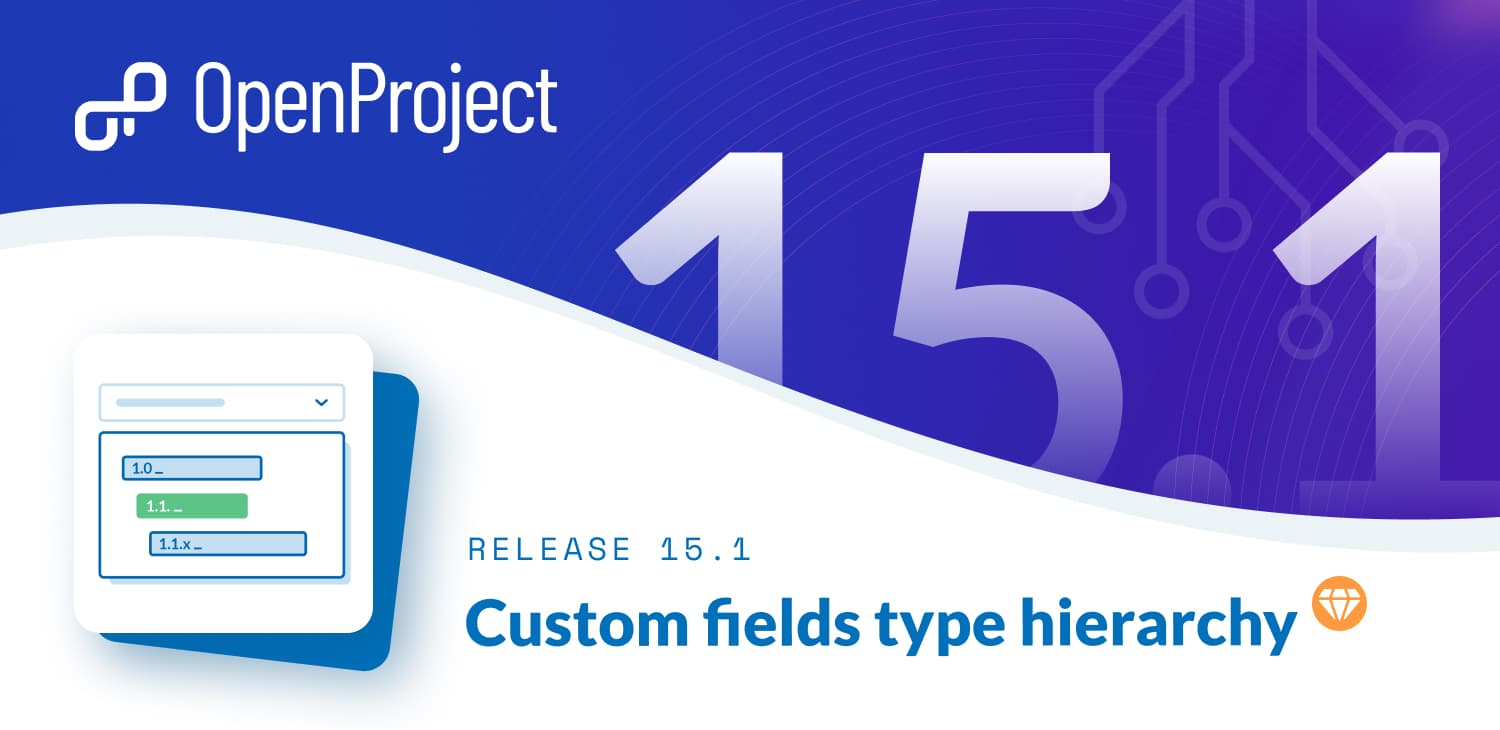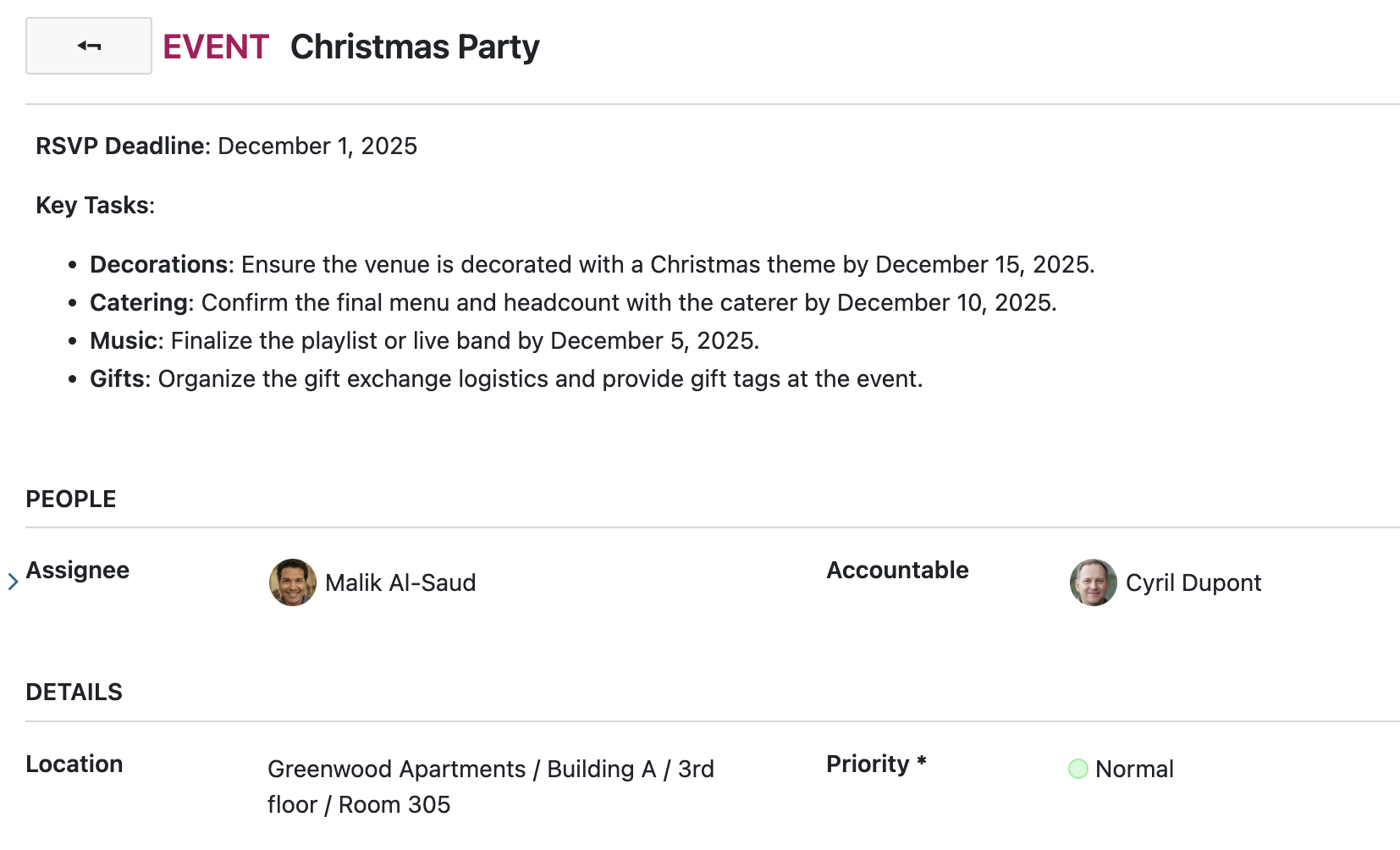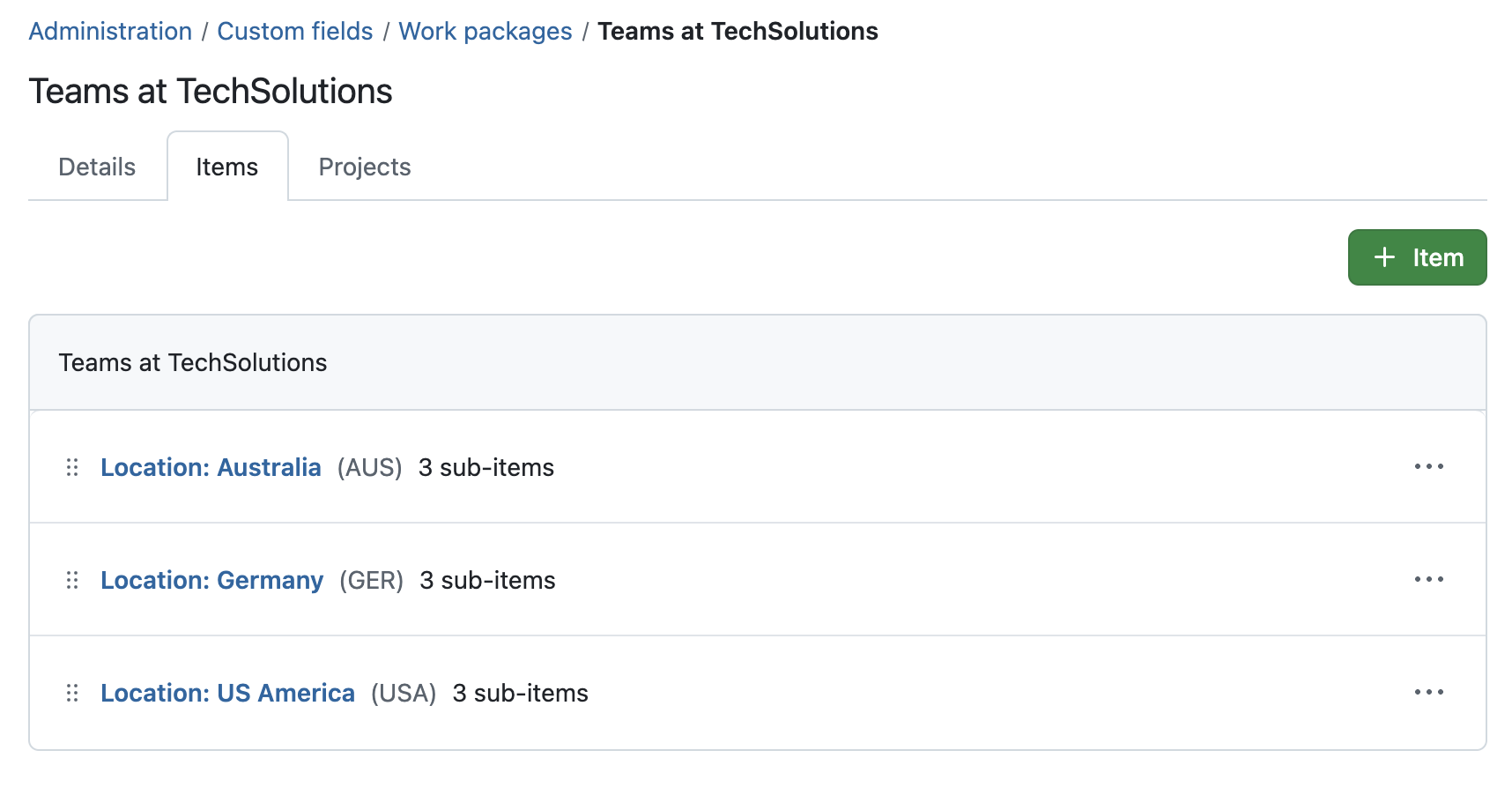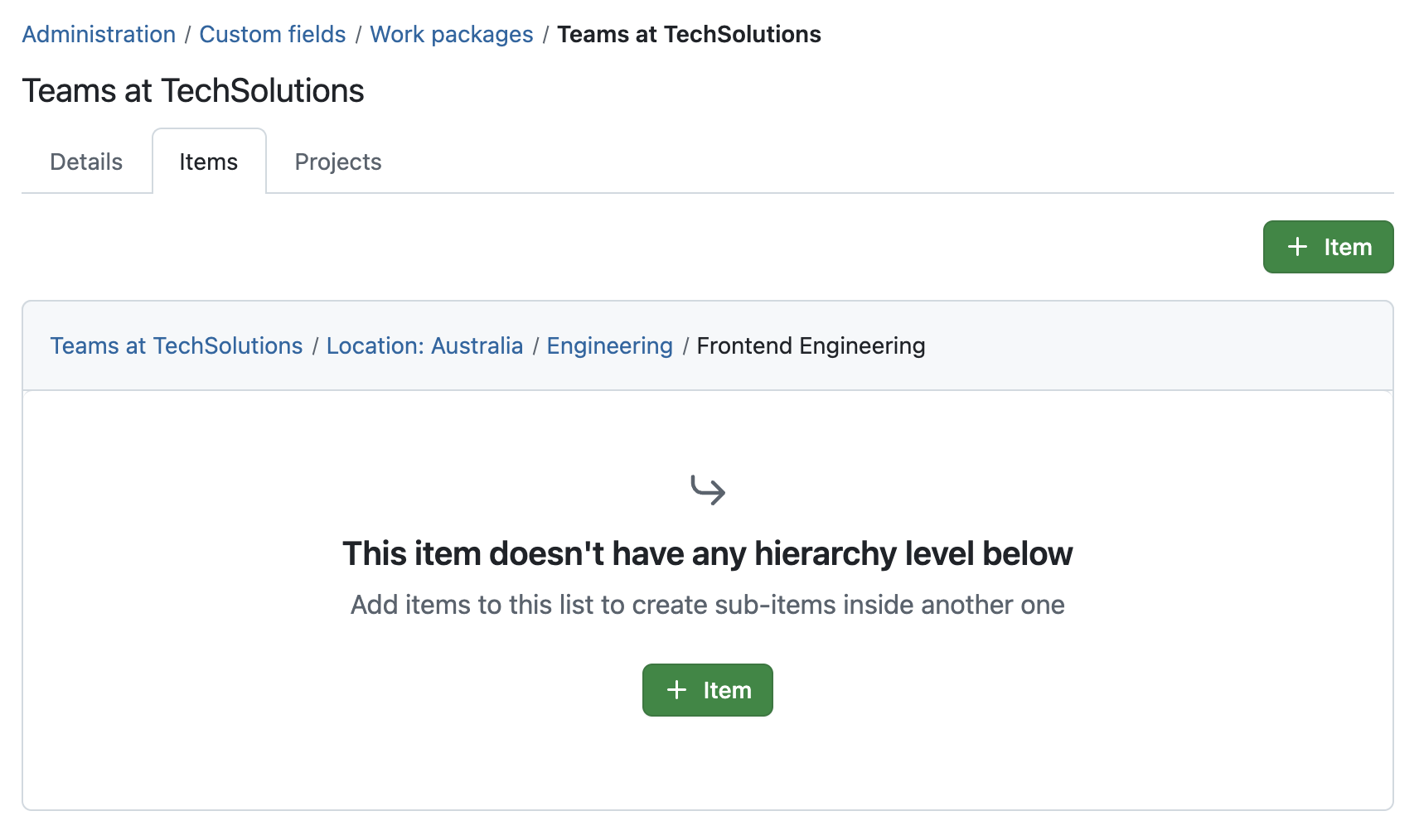
OpenProject 15.1: Custom fields of type hierarchy
We are excited to announce the release of OpenProject 15.1! This update introduces custom fields of type hierarchy (Enterprise add-on), allowing you to structure complex data into multiple levels. Particularly beneficial for larger organizations, this feature streamlines workflows and improves data clarity.
In this blog article, we’ll explore three practical examples of how hierarchical custom fields can be used. For a complete list of all features and bug fixes included in version 15.1, please check out our release notes.
List of important features with OpenProject 15.1
Let’s start with a list of the key features of OpenProject 15.1:
- Custom fields of type hierarchy (Enterprise add-on)
- Redesign of the Relations tab in work packages
- Redesign of the Meetings index page
- Manual page breaks in PDF work package exports
- Zen mode for project lists
In the linked release notes sections, you will find all information on these highlight features for OpenProject 15.1.
In this blog article, we will take a closer look at the new Enterprise add-on and examples on how to use custom fields of type hierarchy.
Custom fields of type hierarchy (Enterprise add-on)
The new custom field type hierarchy introduces multi-level selections make it much easier to organize and navigate complex data in work packages. This feature allows users to structure items into multiple levels, streamlining data categorization and improving clarity.
With hierarchical custom fields, users can assign short identifiers (e.g., “B” for Berlin) to levels, creating a logical and accessible framework. For example, you can use this feature to categorize workspaces with precision, ensuring detailed data is well-organized and easy to manage.
In our system admin guide, you can learn how to create new custom fields of type hierarchy.
But how can you make the most of this new capability? Let’s explore three use cases where hierarchical custom fields can add real value.
- Example 1: Location details and room numbers
- Example 2: Organizational structures
- Example 3: Product categorization
Example 1: Location details and room numbers
In real estate management, keeping track of detailed location information across multiple properties can be a complex task. Hierarchical custom fields in OpenProject simplify this by creating structured levels for properties and their components. Por ejemplo:
- Level 1: Property – “Greenwood Apartments”
- Level 2: Building – “Building A”
- Level 3: Floor – “3rd floor”
- Level 4: Room – “Room 305”
With this structure, a maintenance task could be assigned to Greenwood Apartments > Building A > 3rd floor > Room 305. This ensures that the team knows exactly where to focus their efforts, reducing the risk of misunderstandings.
This approach is not only helpful for property management but also for companies with multiple sites or regional offices. By using a custom field to hierarchically structure locations, it becomes easy to specify location-based work packages, such as events.
Below is an example screenshot of a work package type ‘Event’ that includes the custom field ‘Location’, as described above:

Example 2: Organizational structures
Managing workflows in large organizations can be complex, especially across departments, teams, and locations. Hierarchical custom fields make it easier to categorize and track tasks at any level. Por ejemplo:
- Level 1: Organization – TechSolutions Inc.
- Level 2: Location – Australia
- Level 3: Department – Engineering
- Level 4: Team – Frontend Engineering
If you have multiple ‘Frontend Engineering’ teams in different locations, the hierarchy field specifies exactly which team is responsible, such as the one in Australia. This avoids confusion, ensures tasks are directed to the correct group, and improves transparency.
Here is an example of how an admin could use custom fields type hierarchy to structure and specify the different Engineering teams:

… And this is how this custom field would look like in the fourth level:

Example 3: Product Categorization
In product development, clear categorization is critical to organizing and aligning projects. Hierarchical custom fields help structure products so teams can easily navigate them. Por ejemplo:
- Level 1: Product Line – Electronics
- Level 2: Product Category – Laptops
- Level 3: Model/Version – ProBook X200
With this hierarchy in place, a task like “Update firmware” can be assigned specifically to the product line Electronics > Laptops > ProBook X200. Admins can adjust these fields as product lines evolve, making the structure both robust and adaptable.
OpenProject 15.1: Migration, Installation, Updates and Support
Follow the upgrade guide for the packaged installation or Docker installation to update your OpenProject installation to OpenProject 15.1. We update your hosted OpenProject environments (Enterprise cloud) today, December 11, 2024.
You will find more information about all new features and changes in our Release notes or in the OpenProject Documentation.
If you need support, you can post your questions in the Community Forum, or if you are eligible for Enterprise support, please contact us and we are happy to support you personally.
- New to OpenProject? To test all features of OpenProject 15.1 right away, create a 14 days free trial instance for our OpenProject Enterprise cloud.
- Prefer to run OpenProject 15.1 in your own infrastructure? Here you can find the Installation guidelines for OpenProject.
- Want to upgrade from a Community version to try out the Enterprise add-ons? Get a 14 days free trial token to test the Enterprise add-ons.
Créditos
A very special thank you goes to Deutsche Bahn and City of Cologne for sponsoring parts of this release. Your support, alongside the efforts of our amazing Community, helps drive these innovations.
Also, a big thanks to our Community members for reporting bugs and helping us identify and provide fixes. Special thanks for reporting and finding bugs go to Bill Bai, Sam Yelman, Knight Chang, Gábor Alexovics, Gregor Buergisser, Andrey Dermeyko, Various Interactive, Clayton Belcher, Александр Татаринцев, and Keno Krewer.
Last but not least, we are very grateful for our very engaged translation contributors on Crowdin, who translated quite a few OpenProject strings! This release we would like to highlight
- Alexander Aleschenko, for an outstanding number of translations into Russian.
- José Helbert Pina, for a great number of translations into Portuguese.
- BigSeung, for a great number of translations into Korean.
Would you like to help out with translations yourself? Then take a look at our translation guide and find out exactly how you can contribute. It is very much appreciated!
As always, we welcome any feedback on this release. 💙


